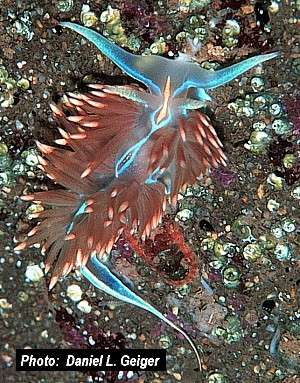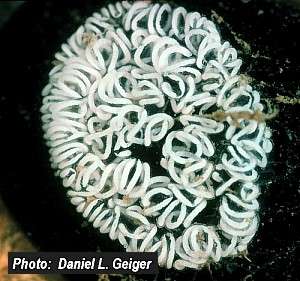

Hermissenda crassicornis
(Eschscholtz, 1831)
Order: NUDIBRANCHIA
Suborder: AEOLIDINA
Family: Glaucidae
DISTRIBUTION
West Coast of North America from Kodiak Island, Alaska to Baja California, Mexico. NW Pacific - Japan and Sth Korea (Behrens & Hermosillo, 2005; Sea Slug Forum records).
PHOTO
UPPER: Monterey Bay Aquarium, California.
LOWER: Egg ribbon, Los Angeles, California.
PHOTOS: Daniel L. Geiger.
The body is translucent clear with a very characteristic pattern of white or bluish-white lines, yellow-orange patches and bluish white dusting. The upper half of both the oral tentacles and the rhinophores are dusted with white. A opaque white line runs from the tip of each oral tentacle down the posterior edge of the dorsal surface of the tentacle to the head. Here it splits in two, one branch running up to join its partner from the other oral tentacle to run down the dorsal midline to the posterior tip of the body. The other branch runs along the edge of the mantle, with breaks between the ceratal clusters. The white lines running between the rhinophores join just behind the rhinophores, then separate again in the interhepatic space behind the first ceratal cluster. They join again about halfway down the body to run as a single line to the posterior tip of the body. There is a bright orange median line [sometimes white yellow or red] which runs from between the rhinophores, forward about halfway across the head. A shorter line of the same colour lies in the interhepatic space between the two white lines. There is also a white line running along the edge of the foot. There is some colour variability in this species, the white lines in particular, can appear quite blue, and sometimes they are a broad faint band, other times there can be a thin intense white line with a broad band of white dusting running alongside. The ceratal colour can also vary. Usually the digestive gland is a shade of brown and the cerata are tipped with white and may have a subapical band of orange. One variety has a white line up each ceras. In others, the ceratal color is faded, forming bands of white and brown. The rhinophores range from almost smooth to slightly wrinkled. In some cases quite distinct rings can be present. It grows to about 50 mm.
References:
• Avila, C. (1999) Chemotaxis in the nudibranch Hermissenda crassicornis: does ingestive conditioning influence it behaviour in a Y-maze? Journal of Molluscan Studies, 64: 215-222
• Avila, C., Tyndale, E., & Kuzirian, A.M. (1998) Feeding behaviour and growth of Hermissenda crassicornis (Mollusca: Nudibranchia) in the Laboratory. Mar. Fresh. Behav. Physiol., 31: 1-19.
• Behrens, D.W. (1980) Pacific Coast Nudibranchs. A guide to the opisthobranchs of the northeastern Pacific. Sea Challengers. Los Osos, California.
• Harrigan, J.F. & Alkon, D.L. (1978). Larval rearing, metamorphosis, growth and reproduction of the aeolid nudibranch Hermissenda crassicornis (Eschscholtz, 1831). Biological Bulletin, 154: 430-439.
•Longley, R.D. & Longley, A.J. (1981) Hermissenda: agonistic behaviour or mating behaviour? The Veliger 24(3):, 230-231.
•Rutowski, R.L. (1983): Mating and egg mass production in the aeolid nudibranch Hermissenda crassicornis (Gastropoda: Opisthobranchia). Biological Bulletin, 165(August): 276-285.
Rudman, W.B., 2003 (August 2) Hermissenda crassicornis (Eschscholtz, 1831). [In] Sea Slug Forum. Australian Museum, Sydney. Available from http://www.seaslugforum.net/factsheet/hermcras
Related messages
-
Hermissenda crassicornis eating Flabellina trilineata
From: John Albers-Mead, August 15, 2007 -
Hermissenda vs. Corynactis
From: Bruce Wight, August 3, 2007 -
Nudibranch Parasite? - Hermissenda
From: Bruce Wight, August 1, 2007 -
Colour variation in Hermissenda crassicornis
From: Carissa Thomas, April 4, 2007 -
Hermissenda crassicornis from Oregon, USA
From: Julie Gilchrist, June 3, 2006 -
Re: Hermissenda crassicornis from Sth Korea
From: Ron Velarde, February 25, 2006 -
Hermissenda crassicornis from Sth Korea
From: Dong Bum Koh, February 24, 2006 -
Hermissenda crassicornis eating ascidians?
From: Marli Wakeling, February 3, 2006 -
Hermissenda crassicornis genetics
From: Martin H. Johnson, December 12, 2005 -
Re: Janolus fuscus from Puget Sound
From: Jeff Goddard, October 5, 2005 -
Re: Janolus fuscus from Puget Sound
From: Jack Connick, October 4, 2005 -
Re: Janolus fuscus from Puget Sound
From: Jack Connick, September 30, 2005 -
Flabellina pricei or mistaken identity
From: Jan Kocian, August 9, 2005 -
Re: Janolus fuscus from Puget Sound
From: Jeff Goddard, July 6, 2005 -
Re: Janolus fuscus from Puget Sound
From: Jack Connick, July 2, 2005 -
Re: Nudibranch eggs will travel
From: Marli Wakeling, May 9, 2005 -
Nudibranch eggs will travel
From: Marli Wakeling, May 7, 2005 -
Re: Raising Hermissenda for research
From: Ray Izumi, May 6, 2005 -
Raising Hermissenda for research
From: Daniel Swezey, April 29, 2005 -
Hermissenda crassicornis Cannibalism?
From: Daniel Swezey, February 28, 2005 -
Hermissenda crassicornis with eggs
From: Bruce Wight, February 10, 2005 -
Hermissenda crassicornis from California
From: Bruce Wight, August 9, 2004 -
Trailing behaviour in Hermissenda crassicornis
From: Marli Wakeling, December 22, 2003 -
Hermissenda - 1000 miles from land
From: Hiroaki Sakoh, November 15, 2003 -
Hermissenda crassicornis feeding
From: Glen Miller and Jackie Hildering, September 30, 2003 -
Hermissenda crassicornis without cerata
From: M.J. Adams, August 14, 2003 -
Hermissenda crassicornis from the Channel Ids, California
From: Bruce Wight, August 5, 2003 -
Hermissenda crassicornis from California
From: Chris Grossman, August 1, 2003 -
Re: Update on Hermissenda ailments
From: Rosemary Romero, July 30, 2003 -
Update on Hermissenda ailments
From: Ian Dow, July 18, 2003 -
Re: Ailments in Hermissenda crassicornis
From: Kathe R. Jensen, July 17, 2003 -
Ailments in Hermissenda crassicornis
From: Ian Dow, July 16, 2003 -
Hermissenda from California
From: Bruce Wight, October 17, 2002 -
Hermissenda crassicornis from British Columbia
From: Marli Wakeling, October 10, 2002 -
Hermissenda crassicornis from San Miguel, Calif.
From: Bruce Wight, August 12, 2002 -
Looking for photos of Hermissenda veligers
From: G. Sparks, July 22, 2001 -
Hermissenda crassicornis question
From: Robert Baker, June 12, 2001 -
Information on Hermissenda crassicornis
From: Bill Rudman, February 17, 2001 -
Variation in Hermissenda crassicornis
From: Bruce Wight, August 4, 2000 -
Hermissenda crassicornis feeding on Geoducks?
From: Pacific Shellfish Institute, August 4, 2000 -
Hermissenda crassicornis from California
From: Bruce Wight, July 15, 2000 -
Hermissenda Mating Preferences...
From: Ty Lim, March 6, 2000 -
Re: Hermissenda
From: Max O'Brien, February 20, 2000 -
Re: mating information
From: Ty Lim, February 16, 2000 -
Mating behaviour in Hermissenda
From: Ty Lim, February 15, 2000 -
Finding out what I see under water
From: Max O'Brien, February 7, 2000 -
Source for Hermissenda crassicornis on E. coast
From: David Chan, October 16, 1999 -
Re: Hermissenda feeding
From: Cesar Megina, July 22, 1999 -
Re: Hermissenda feeding
From: Benjamin Ross, July 21, 1999 -
What is the best food for Hermissenda?
From: Benjamin Ross, July 20, 1999 -
Re: Use of name Hermissenda
From: Bill Rudman, June 23, 1999 -
Correct genus for Hermissenda crassicornis
From: Maria Byrne, May 20, 1999
